Dutch-born actress and singer Ilse Werner (1921-2005) was one of the most popular stars of the German screen during the Nazi years. After the war she became a successful Schlager singer. Her nickname, Ein Frau mit Pfiff, translates as A Woman of Distinction, but also refers to her trademark, whistling.
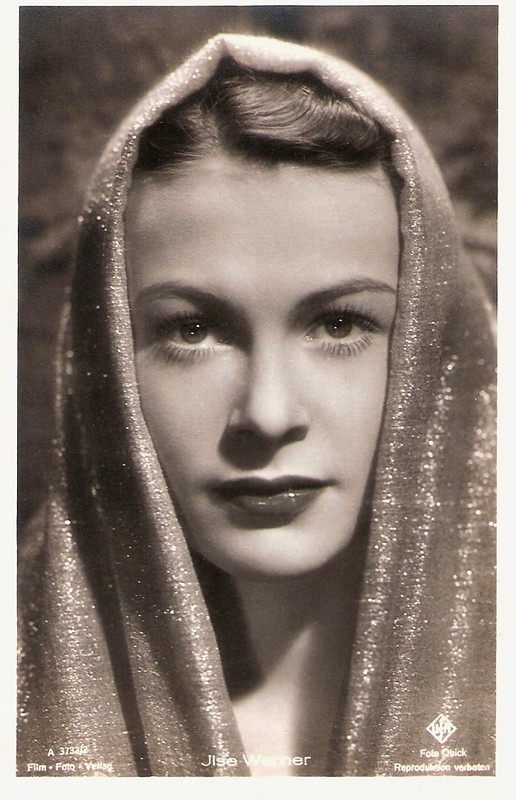
German postcard by Film-Foto-Verlag, no. A 3732/2, 1941-1944. Photo: Quick / Ufa.
Ilse Werner was born Ilse Charlotte Still in Batavia, Dutch East Indies (now Jakarta, Indonesia), in 1921. Her father was a rich Dutch plantation owner and consul, E. O. Still, and her mother, Lilli Still-Werner was German.
After living 10 years on Java, the family returned to Europe and finally settled down in Vienna in 1934. Although Ilse would later have her greatest successes in Germany, she kept her Dutch citizenship until 1955.
In 1936-1937 she followed acting classes at the Max-Reinhardt-Seminar in Vienna, where she changed her name into Ilse Werner.
Her stage debut was at the Viennese Theater in der Josefstadt in the play Glück (Happiness) in 1937, and her film debut was the following year in Finale/Die unruhigen Mädchen/The Restless Girls (Géza von Bolváry, 1938) starring Käthe von Nagy.
The Ufa became interested in the young actress, and the biggest German film studio offered her a contract.
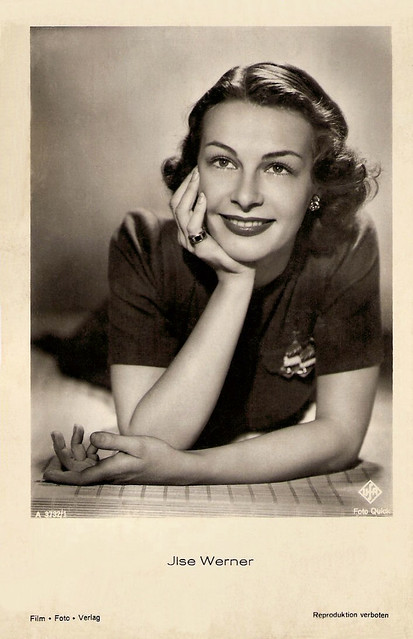
German postcard by Film-Foto-Verlag, no. A 3732/1, 1941-1944. Photo: Quick / Ufa.

German postcard by Film-Foto-Verlag, no. A 3896/1, 1941-1944. Photo: Terra / Quick.

German postcard by Film-Foto-Verlag, no. A 3477/1. Photo: Baumann / Ufa.
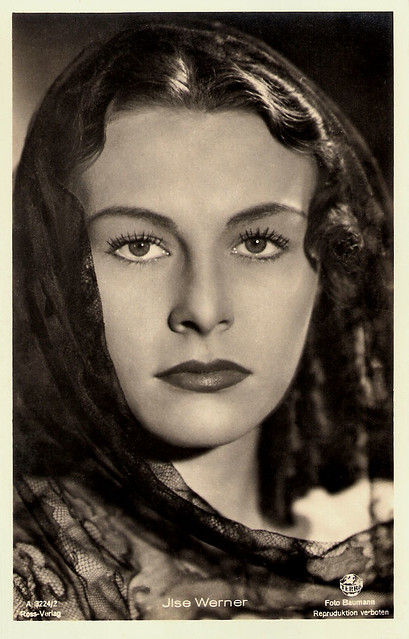
German postcard by Ross-Verlag, no. A 3224/2, 1941-1944. Photo: Baumann / Terra.
Ilse Werner started to work at the legendary Ufa Studios in Babelsberg near Berlin. She appeared in films like Frau Sixta/Mrs. Sixta (Gustav Ucicky, 1938), Das Leben kann so schön sein/Life Can Be So beautiful (Rolf Hansen, 1938), the classic comedy Bel Ami (Willi Forst, 1939) and Bal paré (Karl Ritter, 1940) with Paul Hartmann.
Her breakthrough film was the propaganda film Wunschkonzert/Request Concert (Eduard von Borsody, 1940), an incredibly popular home-front comedy-drama centred around a beloved radio program.
She continued to be a top attraction in popular films like Die schwedische Nachtigall/The Swedish Nightingale (Peter Paul Brauer, 1941) as the famous soprano Jenny Lind, and Wir machen Musik/We're Making Music (Helmut Käutner, 1942) with Viktor de Kowa. She starred opposite Hans Albers in the colour spectacle Münchhausen/The Adventures of Baron Munchausen (Josef von Báky, 1943), and the in the harbour of Hamburg located love story Grosse Freiheit Nr. 7/Port of Freedom (Helmut Käutner, 1944). In the latter film she played her first serious character role.
During the war she worked for the TV station Paul Nipkow and moderated the weekly TV show Wir senden Frohsinn – wir spenden Freude (We Broadcast Cheerfulness, We Donate Joy).
Ilse Werner also made several very popular records such as Sing ein Lied, wenn du mal traurig bist (Sing A Song If You’re Sad Sometimes), Du und ich im Mondenschein (You and Me in the Moonlight) and especially Wir machen Musik (We Make Music).
She became famous for her inimitable whistling, a skill she had picked up as a child and cultivated throughout her career. She often whistled to melodies composed by Werner Bochmann.
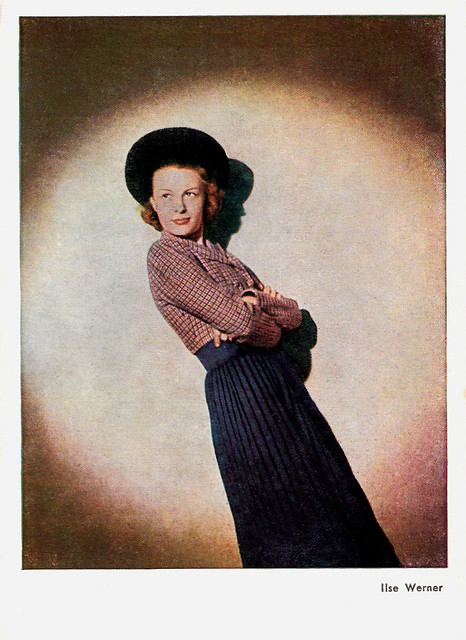
German postcard by Verlag und Druckerei Erwin Preuss, Dresden-Freital, Serie I Die neue farbige Filmstarkarte, no. 15. Photo: Charlott Serda.
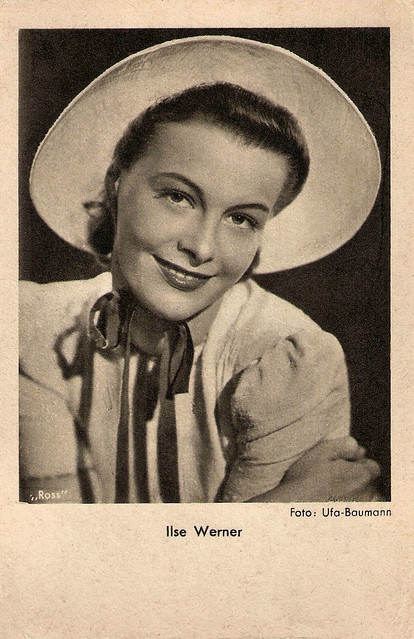
German postcard by Ross, 1941-1944. Photo: Ufa / Baumann.
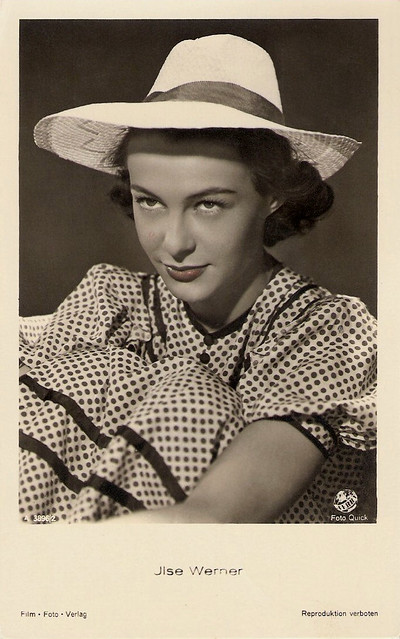
German postcard by Film-Foto-Verlag, no. A 3896/2, 1941-1944. Photo: Terra / Quick.
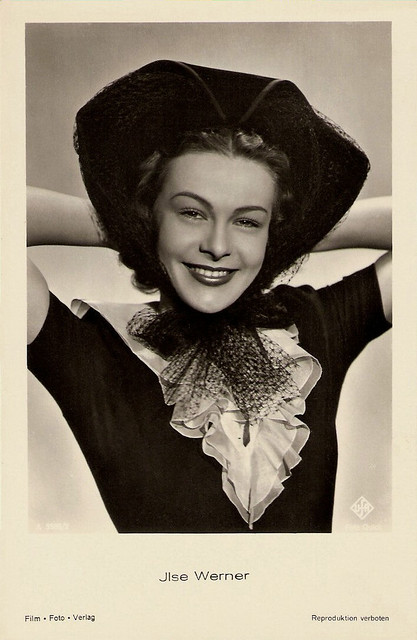
German postcard by Film-Foto-Verlag, no. A 3986/2, 1941-1944. Photo: Ufa.
At the end of World War II, Ilse Werner was temporarily barred from performing in films by the Allies. In the meanwhile she worked as a voice actress for the synchronization of American films. In 1948, she relocated to America with her husband, the American journalist John de Forest. Yet she continued appearing in German films like Geheimnisvolle Tiefe/Mysterious Shadows (Georg Wilhelm Pabst, 1949) and Epilog: Das Geheimnis der Orplid/Epilogue (Helmut Käutner, 1950).
After her 1953 divorce, she returned to Germany and excelled in such dramatic character roles as Queen Marie-Louise in the film operetta Der Vogelhändler/The Bird Seller (Arthur Maria Rabenalt, 1953) with Wolf Albach-Retty. Other films were the romance Ännchen von Tharau (Wolfgang Schleif, 1954) and Griff nach den Sternen/Reaching for the Stars (Carl-Heinz Schroth, 1955) with Erik Schumann.
However, her biggest post-war successes were the records she released between 1957 and 1964. Her song Baciare was in 1960 a hit all over Europe. In the following decades she was successful on the stage in productions like the musical Der König und ich (The King and I) (1970), and on TV, where she had her own variety show Ein Abend mit Pfiff (An Evening of Distinction) (1967).
In 1981 she published her memoirs, So wird's nie wieder sein …Ein Leben mit Pfiff (It Will Never Be Like That Again, A life of Distinction). That same year she was awarded the Bundesverdienstkreuz (Federal Cross of Merit) and in 1986 she also received the Filmband in Gold for her work in the German cinema.
Five years later, she won the award again for her self-ironic portrayal of an ageing Schlager Singer in the tragic comedy Die Hallo-Sisters/The Hallo Sisters (Ottokar Runze, 1990) with Gisela May. It was her last film role; her last TV appearance was in the Krimi Tatort (2000). Ilse Werner died in 2005 in a retirement home in Lübeck at the age of 84. She had been suffering from pneumonia. Werner had been married to John de Forest and later to Josef Niessen, the director of the Nurnberg Dance Orchestra of the Bayerischen Rundfunk (the Bavaria radio station). Both marriages ended in a divorce.
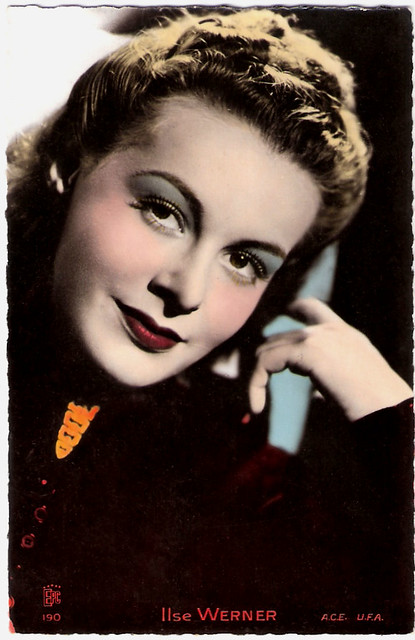
French postcard by EPC, no. 190. Photo: ACE / Ufa.
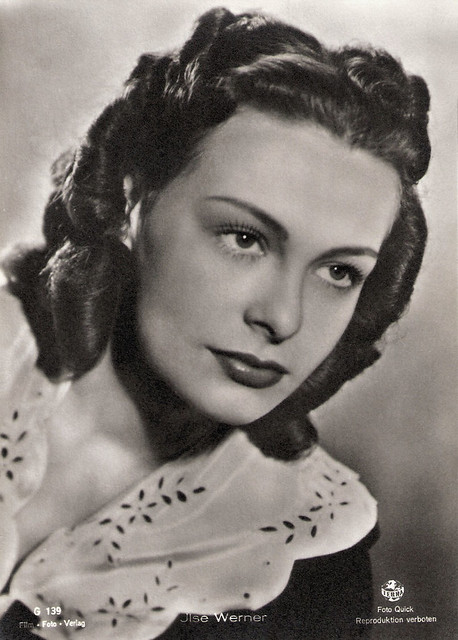
German postcard by Film-Foto-Verlag, no. G 139. Photo: Quick / Terra. From Tatiana.
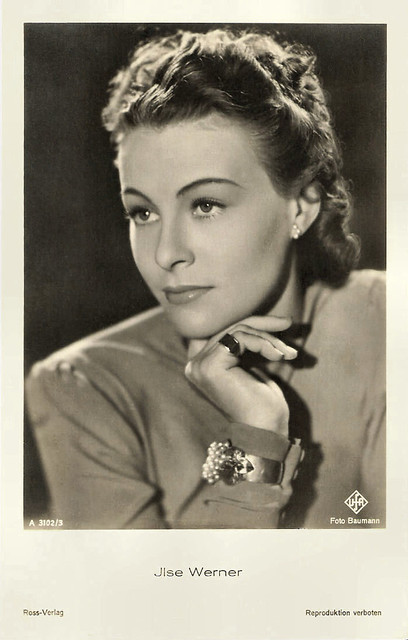
German postcard by Ross-Verlag, no. A 3102/1, 1941-1944. Photo: Baumann / Ufa.
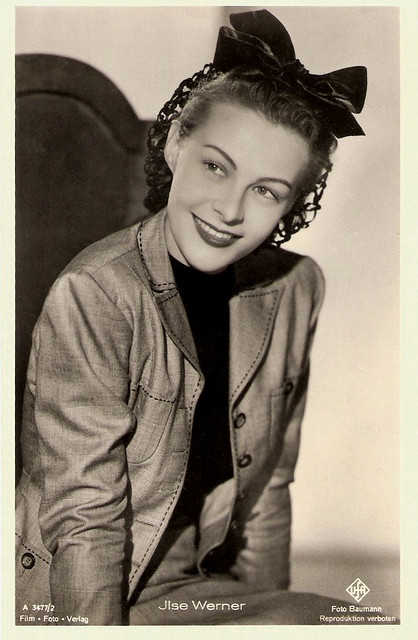
German postcard by Film-Foto-Verlag, no. 3477/2, 1941-1944. Photo: Ufa / Baumann.
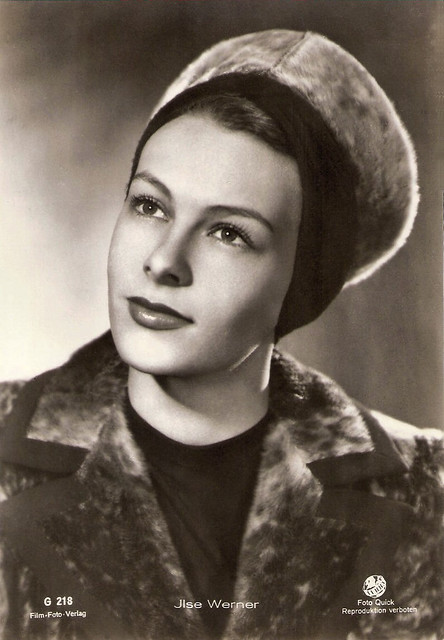
German postcard by Film-Foto-Verlag, no. G 218. Photo: Quick / Terra.
Scene with Ilse Werner from Wir machen Musik/We're Making Music (1942). Source: Robert S (YouTube).
Sources: Stephanie d’Heil (Steffi-line) (German), Thomas Staedeli (Cyranos), Hans J. Wollstein (AllMovie), Wikipedia, and IMDb.

German postcard by Film-Foto-Verlag, no. A 3732/2, 1941-1944. Photo: Quick / Ufa.
The Biggest German Film Studio
Ilse Werner was born Ilse Charlotte Still in Batavia, Dutch East Indies (now Jakarta, Indonesia), in 1921. Her father was a rich Dutch plantation owner and consul, E. O. Still, and her mother, Lilli Still-Werner was German.
After living 10 years on Java, the family returned to Europe and finally settled down in Vienna in 1934. Although Ilse would later have her greatest successes in Germany, she kept her Dutch citizenship until 1955.
In 1936-1937 she followed acting classes at the Max-Reinhardt-Seminar in Vienna, where she changed her name into Ilse Werner.
Her stage debut was at the Viennese Theater in der Josefstadt in the play Glück (Happiness) in 1937, and her film debut was the following year in Finale/Die unruhigen Mädchen/The Restless Girls (Géza von Bolváry, 1938) starring Käthe von Nagy.
The Ufa became interested in the young actress, and the biggest German film studio offered her a contract.

German postcard by Film-Foto-Verlag, no. A 3732/1, 1941-1944. Photo: Quick / Ufa.

German postcard by Film-Foto-Verlag, no. A 3896/1, 1941-1944. Photo: Terra / Quick.

German postcard by Film-Foto-Verlag, no. A 3477/1. Photo: Baumann / Ufa.

German postcard by Ross-Verlag, no. A 3224/2, 1941-1944. Photo: Baumann / Terra.
Propaganda Film
Ilse Werner started to work at the legendary Ufa Studios in Babelsberg near Berlin. She appeared in films like Frau Sixta/Mrs. Sixta (Gustav Ucicky, 1938), Das Leben kann so schön sein/Life Can Be So beautiful (Rolf Hansen, 1938), the classic comedy Bel Ami (Willi Forst, 1939) and Bal paré (Karl Ritter, 1940) with Paul Hartmann.
Her breakthrough film was the propaganda film Wunschkonzert/Request Concert (Eduard von Borsody, 1940), an incredibly popular home-front comedy-drama centred around a beloved radio program.
She continued to be a top attraction in popular films like Die schwedische Nachtigall/The Swedish Nightingale (Peter Paul Brauer, 1941) as the famous soprano Jenny Lind, and Wir machen Musik/We're Making Music (Helmut Käutner, 1942) with Viktor de Kowa. She starred opposite Hans Albers in the colour spectacle Münchhausen/The Adventures of Baron Munchausen (Josef von Báky, 1943), and the in the harbour of Hamburg located love story Grosse Freiheit Nr. 7/Port of Freedom (Helmut Käutner, 1944). In the latter film she played her first serious character role.
During the war she worked for the TV station Paul Nipkow and moderated the weekly TV show Wir senden Frohsinn – wir spenden Freude (We Broadcast Cheerfulness, We Donate Joy).
Ilse Werner also made several very popular records such as Sing ein Lied, wenn du mal traurig bist (Sing A Song If You’re Sad Sometimes), Du und ich im Mondenschein (You and Me in the Moonlight) and especially Wir machen Musik (We Make Music).
She became famous for her inimitable whistling, a skill she had picked up as a child and cultivated throughout her career. She often whistled to melodies composed by Werner Bochmann.

German postcard by Verlag und Druckerei Erwin Preuss, Dresden-Freital, Serie I Die neue farbige Filmstarkarte, no. 15. Photo: Charlott Serda.

German postcard by Ross, 1941-1944. Photo: Ufa / Baumann.

German postcard by Film-Foto-Verlag, no. A 3896/2, 1941-1944. Photo: Terra / Quick.

German postcard by Film-Foto-Verlag, no. A 3986/2, 1941-1944. Photo: Ufa.
Barred From Performing
At the end of World War II, Ilse Werner was temporarily barred from performing in films by the Allies. In the meanwhile she worked as a voice actress for the synchronization of American films. In 1948, she relocated to America with her husband, the American journalist John de Forest. Yet she continued appearing in German films like Geheimnisvolle Tiefe/Mysterious Shadows (Georg Wilhelm Pabst, 1949) and Epilog: Das Geheimnis der Orplid/Epilogue (Helmut Käutner, 1950).
After her 1953 divorce, she returned to Germany and excelled in such dramatic character roles as Queen Marie-Louise in the film operetta Der Vogelhändler/The Bird Seller (Arthur Maria Rabenalt, 1953) with Wolf Albach-Retty. Other films were the romance Ännchen von Tharau (Wolfgang Schleif, 1954) and Griff nach den Sternen/Reaching for the Stars (Carl-Heinz Schroth, 1955) with Erik Schumann.
However, her biggest post-war successes were the records she released between 1957 and 1964. Her song Baciare was in 1960 a hit all over Europe. In the following decades she was successful on the stage in productions like the musical Der König und ich (The King and I) (1970), and on TV, where she had her own variety show Ein Abend mit Pfiff (An Evening of Distinction) (1967).
In 1981 she published her memoirs, So wird's nie wieder sein …Ein Leben mit Pfiff (It Will Never Be Like That Again, A life of Distinction). That same year she was awarded the Bundesverdienstkreuz (Federal Cross of Merit) and in 1986 she also received the Filmband in Gold for her work in the German cinema.
Five years later, she won the award again for her self-ironic portrayal of an ageing Schlager Singer in the tragic comedy Die Hallo-Sisters/The Hallo Sisters (Ottokar Runze, 1990) with Gisela May. It was her last film role; her last TV appearance was in the Krimi Tatort (2000). Ilse Werner died in 2005 in a retirement home in Lübeck at the age of 84. She had been suffering from pneumonia. Werner had been married to John de Forest and later to Josef Niessen, the director of the Nurnberg Dance Orchestra of the Bayerischen Rundfunk (the Bavaria radio station). Both marriages ended in a divorce.

French postcard by EPC, no. 190. Photo: ACE / Ufa.

German postcard by Film-Foto-Verlag, no. G 139. Photo: Quick / Terra. From Tatiana.

German postcard by Ross-Verlag, no. A 3102/1, 1941-1944. Photo: Baumann / Ufa.

German postcard by Film-Foto-Verlag, no. 3477/2, 1941-1944. Photo: Ufa / Baumann.

German postcard by Film-Foto-Verlag, no. G 218. Photo: Quick / Terra.
Scene with Ilse Werner from Wir machen Musik/We're Making Music (1942). Source: Robert S (YouTube).
Sources: Stephanie d’Heil (Steffi-line) (German), Thomas Staedeli (Cyranos), Hans J. Wollstein (AllMovie), Wikipedia, and IMDb.
1 comment:
So many actors and actresses I don't know!
Post a Comment